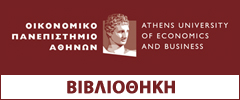| Abstract : | Η παρούσα διπλωματική εργασία εξετάζει την αποτελεσματικότητα της αντιστάθμισης στην αγορά των ναύλων για τα δρομολόγια C3 και Average of 5 Time-Charter routes του Baltic Capesize Index. Για τον έλεγχο, εκτιμώνται δυναμικοί και σταθεροί λόγοι αντιστάθμισης. Η εκτίμηση των πρώτων ροπών γίνεται μέσω ενός bivariate Vector Autoregression Model με μία GARCH δομή στη διακύμανση των καταλοίπων. Στην συνέχεια, για την εξαγωγή συμπερασμάτων αναφορικά με την αποτελεσματικότητα, διενεργούνται in-sample και out-of-sample tests. Επιπλέον, επανεκτιμώνται οι λόγοι αντιστάθμισης και αξιολογούνται βάση ενός περιορισμένου δείγματος, το οποίο έχει αποκλείσει την περίοδο έξαρσης του ιού SARS-CoV-2, ώστε να ελεγχθούν τα δεδομένα σε περίοδο μη κρίσης. Τα αποτελέσματα των in-sample tests υποδεικνύουν ως βέλτιστο τρόπο υπολογισμού του hedge ratio, τον δυναμικό λόγο αντιστάθμισης σχεδόν σε όλες τις περιπτώσεις, ενώ τα αντίστοιχα out-of-sample tests προτείνουν διαφορετικούς λόγους, οι οποίοι μεταβάλλονται με βάση το δρομολόγιο ή την περίοδο που εκτιμάται.
The present master thesis investigates the hedging effectiveness in the freight rates market for the C3 route and the Average of 5 Time-Charter routes of the Baltic Capesize Index. In order to examine it, time-varying and constant hedge ratios are estimated. The first moments of the dataset are estimated with a bivariate Vector Autoregression Model, using a GARCH error structure. With the intention of drawing conclusions, in-sample and out-of-sample tests are performed. In addition, a new restricted dataset is used to estimate and evaluate the hedge ratios, by excluding the period of SARS-CoV-2 of the original data, for the purpose of examining hedging effectiveness of a non-crisis period of time. The results of in-sample tests indicate time-varying hedge ratios as the most appropriate in most cases, while out-of-sample tests reveal the best method to hedge freight rates risks is changing, depending on the specific route or the period which is estimated.
|
|---|







 Copyright © 2013 Library AUEB. All rights reserved.
Copyright © 2013 Library AUEB. All rights reserved.